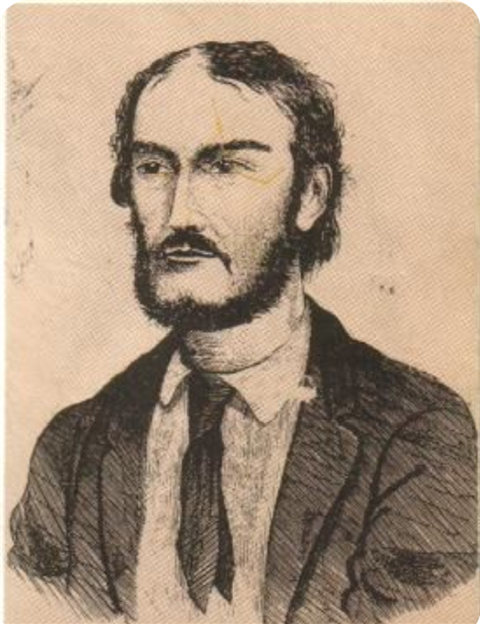Captain Thunderbolt

Captain Thunderbolt
The last of the New South Wales bushrangers, Frederick Wordsworth Ward, better known as "Captain Thunderbolt", ruled the highways and byways of New England High Country and beyond for much of the 1860s.
Fred was born in the Windsor district of New South Wales during the mid-1830s. His family later moved north to the Maitland district, where in 1853, he began working at the famous ‘Tocal’ horse stud as a horse-breaker and stock hand.
In 1856, close relative, John Garbutt, became the ringleader of a large horse and cattle stealing operation, and enticed other members of the extended Ward family to join him. Fred helped drive some four dozen of the stolen horses (many from Tocal) to Windsor. The horses were recognised and Fred was subsequently arrested and found guilty of “receiving” stolen horses. He was sentenced to 10 years hard labour at Sydney’s infamous Cockatoo Island prison.
After four years in prison, he was released on a “ticket-of-leave” to the Mudgee district. Here he met a young woman named Mary Ann Bugg, the daughter of a convict shepherd and his Aboriginal wife. Mary Ann fell pregnant to Fred who took her to her father's farm near Dungog for the baby's birth. After leaving her with her family, he rode back to Mudgee, but arrived late for his muster on a ‘borrowed’ horse. As a result, he was returned to Cockatoo Island to complete his original sentence with an additional three years for possessing a “stolen” horse.
On 11 September 1863, Fred and a companion, Frederick Britten, slipped away from their work gang before swimming to freedom through Sydney Harbour’s shark-infested waters. The pair made their way north where, late in October, they were spotted by police near the Big Rock (now Thunderbolt's Rock), south of Uralla. A gun battle ensued, with Fred being shot in the left knee before making his escape into a nearby swamp. The two fugitives soon separated with Fred travelling south to the Maitland district. On 22 December 1863, he robbed a toll-bar operator at Rutherford, west of Maitland, afterwards informing his victim that his name was "Thunderbolt".
Soon afterwards, Fred collected Mary Ann and they headed for the lawless north-western plains where they remained quiet until early 1865. Fred then formed his first gang when he joined forces with three other men, launching a bushranging spree that ended when one of the gang members was shot at Millie in April 1865. Later that same year, he joined forces with another two felons but his second gang disbanded soon after one of them shot a policeman during a shootout at Carroll.
Fred returned to Mary Ann, taking her back to the Gloucester district where they hid out in the isolated mountains. In March 1866, Mary Ann was captured by police and imprisoned on vagrancy charges, but was released after a Parliamentary outcry. Fred resumed bushranging activities in 1867 after Mary Ann was again captured by the police and imprisoned.
After acquiring a young apprentice, Thomas Mason, Fred was active again, robbing mails, inns and stores in the Tamworth and New England districts. Mason was captured by police in September 1867. In 1868, Fred took on new apprentice, William Monckton, and picked up where he had left off. They separated in December of that year and, a few weeks later, Monckton was also captured by police.
During the following year-and-a-half, Fred ventured out on only a handful of occasions. He was shot and killed at Kentucky Creek, near Uralla, on 25 May 1870 by Constable Alexander Binning Walker. He now lays at rest in the Uralla Pioneer Cemetery where his headstone has become a popular attraction for visitors.
Sources: based on information from Wikipedia and www.thunderboltbushranger.com.au.
While in Uralla don't miss these Thunderbolt related sites -
- McCrossin's Mill Museum - "The Life and Legend of Thunderbolt" Exhibit
This recently refurbished exhibit contains artefacts used by Captain Thunderbolt during his daring escapades.
- Thunderbolt’s Grave
Located in Uralla’s Pioneer Cemetery, this headstone was erected by residents of Uralla as a memorial to Captain Thunderbolt.
- Thunderbolt's Rock
Originally known as Split Rock, this huge cluster of granite boulders is located 6km south of Uralla on the New England Highway. The rocks were infamously used by Captain Thunderbolt as a vantage point for detecting approaching mail coaches.
- Thunderbolt Statue
Found casting his steely gaze over Uralla’s main street, this life size statue of Captain Thunderbolt was produced as a Bicentennial project and designed and cast by sculptor, Denis Adams. It was unveiled with much pomp and ceremony in 1988.
- Constable Walker Memorial Plaque
Sitting quietly a few metres east of Thunderbolt’s Statue, this often over-looked memorial was produced in 1970, at the time of the centenary of the death of Captain Thunderbolt, and commemorates the bravery of Constable Walker.
- Click the link below and listen to the dramatic story which includes the The Famous Orphans & Urchins Choir - a project of Rotary Club of Uralla from 1992.